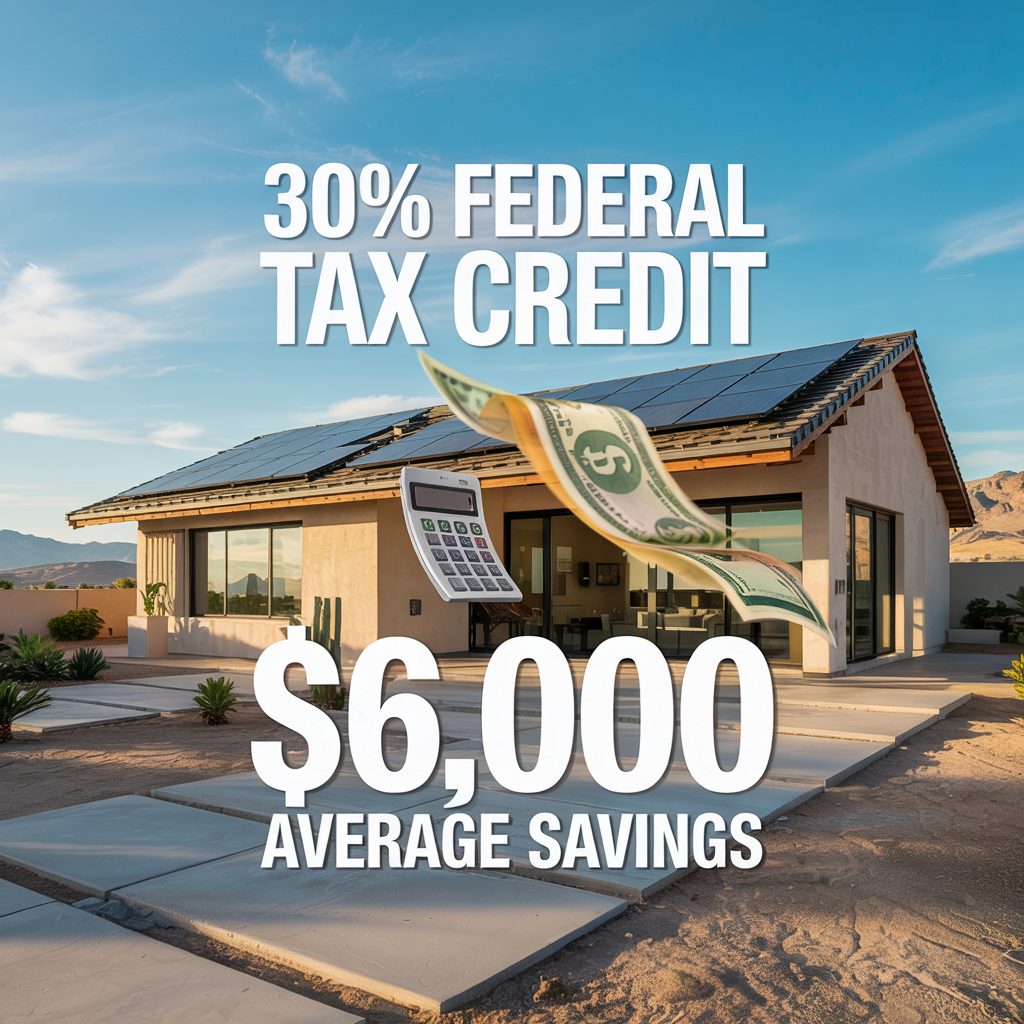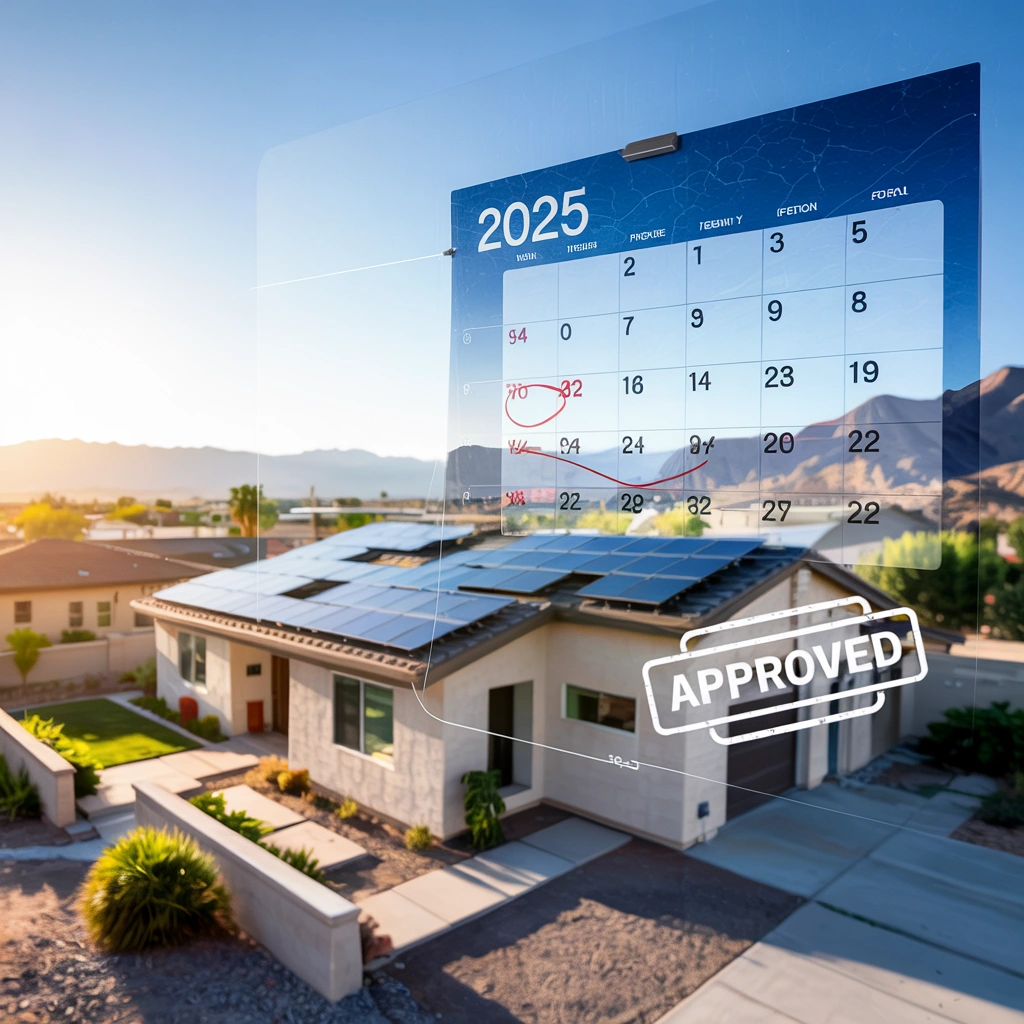
How to Calculate Your 2025 Federal Solar Tax Credit for a Las Vegas Home
Summary: Las Vegas homeowners have until December 31, 2025 to claim a 30% federal solar tax credit worth thousands of dollars—but there’s a specific calculation method and strict requirements you need to know to maximize your savings.
Key Takeaways:
- Las Vegas homeowners can claim 30% of their solar installation costs as a federal tax credit in 2025 by completing IRS Form 5695 and meeting specific eligibility requirements.
- The federal solar tax credit ends December 31, 2025, due to the One Big Beautiful Bill (OBBB), making this the final opportunity to claim this substantial savings.
- A typical 6kW solar system costing $18,000 in Las Vegas results in a $5,400 tax credit, reducing the actual investment to $12,600.
- Battery storage systems also qualify for the same 30% credit when paired with solar installations.
- Nevada’s net metering program provides additional ongoing savings beyond the one-time federal tax credit.
The clock is ticking for Las Vegas homeowners considering solar panel installation. The federal government’s 30% Residential Clean Energy Credit represents thousands of dollars in tax savings, but this opportunity disappears forever on December 31, 2025. With Las Vegas receiving approximately 310 sunny days annually, the combination of excellent solar conditions and substantial tax benefits creates an ideal window for solar investment that won’t exist after this year.
Federal Solar Tax Credit Ends December 31, 2025 Due to One Big Beautiful Bill
The One Big Beautiful Bill (OBBB) signed into law officially terminates the federal solar tax credit program after December 31, 2025. This legislation eliminates what has been one of the most significant renewable energy incentives in U.S. history. Industry analysis shows the urgency of this deadline for Nevada homeowners who want to capture these substantial savings before they disappear permanently.
The timing creates urgency for Las Vegas residents. Solar installations typically require 8-12 weeks from contract signing to system activation. With permit approvals, equipment procurement, and installation scheduling, homeowners need to begin the process immediately to ensure their systems are operational before the deadline.
Unlike previous solar credit reductions that happened gradually, OBBB creates a complete elimination. After December 31, 2025, no federal tax credits will be available for residential solar installations, regardless of when the project was started or contracted.
Federal Solar Tax Credit Requirements for Las Vegas Homeowners
1. Own Your Solar System (Not Lease)
Ownership is the fundamental requirement for claiming the federal tax credit. Homeowners must purchase their solar system through cash payment or solar loans. Leased solar systems don’t qualify because the leasing company retains ownership and claims the credit themselves.
Solar loans maintain eligibility as long as the homeowner holds the title to the system. Most solar financing options preserve ownership rights while spreading payments over time. Power purchase agreements (PPAs) and solar leases disqualify homeowners from the credit since these arrangements transfer ownership to third parties.
2. Owe Federal Income Taxes to Benefit
The solar credit only reduces federal income tax liability to zero. It functions as a non-refundable credit, meaning it can’t create a refund beyond taxes already paid. Homeowners without sufficient tax liability can carry unused credits forward to future tax years, though IRS guidance on carryforward provisions may change in 2025.
Las Vegas homeowners should review their tax situation with qualified professionals to understand how the credit applies to their specific circumstances. High earners typically maximize the credit’s value in the installation year, while others may need multiple years to fully utilize the benefit.
3. Complete Installation Before January 1, 2026
The system must be fully installed and operational during the 2025 tax year to qualify. Partial installations or systems not yet producing electricity don’t meet the requirements. Installation completion means the system is interconnected with NV Energy and generating power.
Documentation proving installation completion becomes crucial for tax filing purposes. Homeowners need certificates from their installer and utility interconnection approvals showing the system began operation in 2025.
Calculating Your 30% Federal Credit Amount
What Solar Expenses Count Toward Credit
The federal credit applies to qualified solar expenses, which include solar panels, inverters, mounting hardware, electrical components, installation labor, permits, inspections, and sales tax on equipment. These direct solar costs form the basis for credit calculations.
Non-qualifying expenses include general roof repairs, extended warranties beyond manufacturer coverage, loan interest or financing fees, and maintenance contracts. Only expenses directly related to the solar energy system qualify for the credit calculation.
Las Vegas Installation Costs and Real Examples
Current Las Vegas solar pricing averages $2.50 to $2.85 per watt before incentives. A typical 6kW system costs approximately $15,000 to $17,000, while larger 8kW systems range from $20,000 to $22,800. These costs include equipment, installation, permits, and interconnection fees.
Consider the Martinez family’s Henderson installation: their 7kW system cost $19,600 in qualified expenses. The 30% credit calculation yielded $5,880 in tax savings, reducing their actual investment to $13,720. This represents substantial savings that won’t be available after 2025.
How Tax Liability Limits Your Benefit
The credit amount equals 30% of qualified expenses, but the benefit is limited by federal tax liability. Homeowners owing $3,000 in federal taxes can only use $3,000 of credit in that tax year, regardless of the credit amount earned.
Unused credits carry forward to future years, though homeowners should consult tax professionals about potential changes to carryforward provisions. The Johnson family from Summerlin earned a $6,200 credit but only owed $4,500 in taxes. They used $4,500 in 2025 and carried $1,700 forward to 2026, maintaining the full benefit over multiple years.
Filing IRS Form 5695 for Your Solar Credit
Required Documentation to Keep
Homeowners must maintain detailed installation records including final invoices showing qualified expenses, equipment specifications and certifications, installation completion certificates, permit approvals, and utility interconnection documents. These records support the credit claim and provide audit protection.
The IRS doesn’t require documentation submission with tax returns, but homeowners should organize records immediately after installation. Missing documentation can jeopardize credit claims during audits or prevent proper credit calculations.
Completing the Residential Clean Energy Section
Form 5695 includes specific sections for different clean energy technologies. Solar installations use the “solar electric property” section where homeowners enter qualified costs. The form automatically calculates 30% of these expenses as the available credit.
Accuracy in expense reporting is crucial. Only include costs directly related to solar energy system installation and operation. Separate any non-qualifying expenses like roof repairs or general electrical work to avoid inflating the credit calculation.
Carrying Unused Credits to Future Tax Years
When credit amounts exceed tax liability, the excess carries forward automatically. Form 5695 tracks these carryover amounts, and subsequent tax returns apply unused credits against future tax liabilities until fully consumed.
This carryover provision protects homeowners with lower tax liability from losing credit benefits. The unused portion retains its full value and applies against future federal income taxes, though homeowners should verify current IRS guidance on carryforward provisions.
Nevada Has No State Solar Credits But Offers Net Metering
NV Energy’s Net Metering Program Details
Nevada doesn’t provide state-level solar tax credits, making the federal credit the primary tax incentive. However, NV Energy’s net metering program provides ongoing savings by crediting excess solar production. Current rates for new installations should be verified with NV Energy as policies can change.
Net metering operates on monthly billing cycles where solar energy sent to the grid offsets electricity purchased from NV Energy. During peak production months, homeowners often generate credits that offset usage during less productive periods, creating year-round savings.
How Utility Credits Work With Federal Tax Benefits
Net metering credits provide operational savings separate from installation tax benefits. These ongoing utility credits don’t affect federal tax credit calculations since they represent energy production payments rather than installation cost reductions.
The combination creates dual savings streams: one-time federal tax credits reduce initial investment costs, while ongoing net metering credits reduce monthly electricity bills. This pairing maximizes the financial benefits of Las Vegas solar installations throughout the system’s operational life.
Battery Storage Systems Also Qualify for 30% Federal Credit
Residential battery storage systems qualify for the same 30% federal tax credit when installed with solar panels or added to existing solar installations. The battery must have at least 3 kilowatt-hours of storage capacity and charge exclusively from the associated solar system to qualify.
Popular battery options in Las Vegas include Tesla Powerwall, LG Chem RESU, and Enphase batteries, with costs ranging from $10,000 to $15,000 installed. The 30% credit reduces these costs by $3,000 to $4,500, making battery backup more affordable for Las Vegas homeowners concerned about grid reliability.
Battery storage adds energy independence and backup power during outages while qualifying for the same tax benefits as solar panels. With Nevada’s occasional extreme weather events, backup power provides valuable peace of mind alongside financial benefits.
Install Solar by December 31, 2025 to Claim Your Final Federal Tax Credit
The December 31, 2025 deadline is firm and final. Solar systems must be completely installed, inspected, and operational before January 1, 2026 to qualify for the federal credit. The OBBB legislation provides no extensions or grandfather clauses for projects started but not completed by the deadline.
Las Vegas homeowners should begin the solar process immediately to ensure completion before the deadline. Installation timelines can extend due to permit delays, equipment availability, or weather conditions. Starting early provides buffer time to handle unexpected delays while securing this valuable tax benefit.
The combination of Las Vegas’s excellent solar conditions, current equipment pricing, and the final opportunity for 30% federal tax credits creates optimal conditions for solar investment. After 2025, homeowners will rely solely on electricity savings and any remaining utility incentives to justify solar installations.
The window for federal solar tax credit savings closes permanently on December 31, 2025, making immediate action necessary for Las Vegas homeowners who want to capture these substantial tax benefits. M&J Trusted Marketing specializes in helping Nevada homeowners navigate solar incentives and installation timelines to maximize their renewable energy investments.
Frequently Asked Questions
How Solar Installation Companies Can Leverage This Content
This informative article, “How to Calculate Your 2025 OBBB Solar Tax Credit for a Las Vegas Home.” can be adapted and repurposed across multiple marketing formats to help increase website traffic for kitchen remodeling services, build trust with potential clients, and differentiate their services in a competitive market. We help with “Engage and Convert: Build Trust With Every Piece of Solar Marketing Content“ by transforming technical content into powerful marketing campaigns across all digital channels, ensuring maximum reach and engagement with potential customers.






